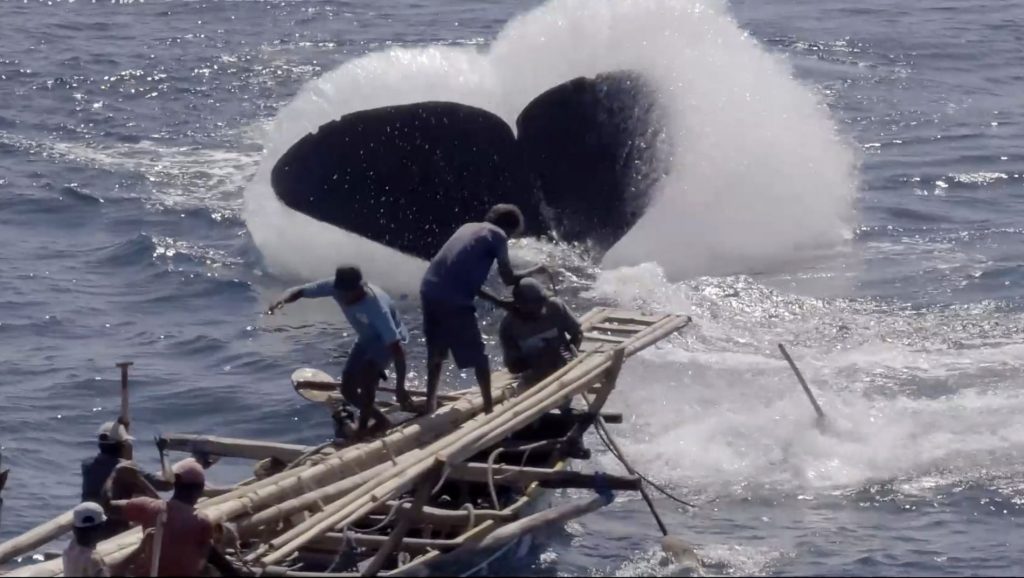Lamafa, an independent documentary about traditional life in a distant Indonesian whaling village, has continued to impress modern audiences around the globe, and was selected by viewers as the best film at the Guam International Film Festival (GIFF).
The festival announced Monday, November 29, that the documentary, produced, written, and directed by Japanese photographer Bon Ishikawa, has been voted as the recipient of this year’s Audience Choice Award. The award adds to growing praise for the film, which was earlier selected as the Grand Jury Award Winner at the festival. The documentary has won over viewers during its modest theater run in Japan, with strong reviews and extended showings across the country.
Lamafa was filmed over three decades of close interactions by Ishikawa in the tiny seaside village of Lamalera, where residents risk their lives to hunt massive sperm whales using only primitive harpoons. While the movie holds nothing back in showing dramatic and bloody whaling scenes, its deeper messages are resonating with audiences.
“It has universal themes of survival, resilience, and cultural preservation,” Dr. Tom Brislin, head of the festival’s jury panel, said in an email interview. “The filmmaker brings us face-to-face with the villagers and hunters in dynamic cinematography and editing. The audience feels a part of the narrative, the most compelling place to be.”
While whaling for food is generally accepted in Japan, it is widely condemned in much of the world. Ishikawa said he was glad that international audiences had not judged his work because it depicted hunts involving a widely beloved animal.
Due to the coronavirus, this year’s GIFF was held online, and virtual attendees that voted for the audience choice award did so from countries including Japan, US, New Zealand, France, Sweden, Ukraine, Canada, Luxembourg, Korea and Micronesia.
“The movie is more about the effects of globalism than it is about whaling,” said Ishikawa.
Ishikawa financed the film personally and through crowdfunding, freeing him from outside influences and allowing him to take the time to develop deep relationships with the villagers and whalers he portrays. The movie’s most exciting scenes use drones, steady cams, and underwater photography to show the courageous “lamafa” whalers as they hunt massive sperm whales in traditional fashion, by leaping into the sea to drive their long harpoons home. It also shows the fray from the whales’ point of view, including harrowing audio of their cries as the hunters close in.
But the relationships and trust Ishikawa built over decades also allow him to introduce audiences to more intimate scenes, such as quiet family dinners, funeral ceremonies, local markets, church gatherings, and even a shaman ceremony.
Dr. Brislin said that Lamafa upholds a tradition of smaller documentaries that seek to introduce remote cultures and ways of life.
“What we call ‘Indigenous Films’ are generally character-driven, marked with a definite ‘sense of place,’ where the land, environment, etc., approaches the level of a character in the film. You can contrast that with blockbuster ‘Franchise Films’ that are plot and action driven that could take place anywhere, with characters in service of the plot,” he said.
The villagers in Lamafa ー Japanese title Kujirabito, or “The Whale People” ー are shown building everything they need for their hunting voyages from scratch. Specialists forge harpoons by hand and assemble their tough wooden boats, while the whole village participates in braiding rope and divvying up whale meat after a catch. Villagers then exchange whale meat for fruit and other staples at a local market.
Commercial whaling is banned internationally for adherents to the International Convention for the Regulation of Whaling (ICRW), but exceptions are granted for traditional whaling by indigenous peoples. Indonesia is not a part of the convention, and the local hunts are permitted under domestic law. Villagers also hunt other large sea life, including manta rays, dolphins, and whale sharks.
Isihikawa is a professional photographer who has been capturing images and video in Lamafa for nearly 30 years. His book of pictures on the town, “The Last Whale Hunter,” was published in 1997. Lamafa is his second film; his first was The Most Beautiful Village in the World, which he created to support Nepal in the aftermath of a major earthquake in 2015. He also produced that film almost entirely on his own, receiving high praise within the domestic film industry.
The GIFF was founded in 2011, and is the only American film festival held in the region. It primarily features films by independent filmmakers, accepting entries internationally while also highlighting local works. Its Best Made in the Marianas award in 2021 went to Kåntan Hereru — A Blacksmith’s Song directed by Sean Lizama. Organizers said they hope to provide an alternative to the corporate films commonly featured at chain theaters.
“I’d like to think that a festival such as GIFF can give a glimpse, especially to a younger audience, of a wider, more interesting world through cinema than the one found at the mall’s cineplex,” said Dr. Brislin.
